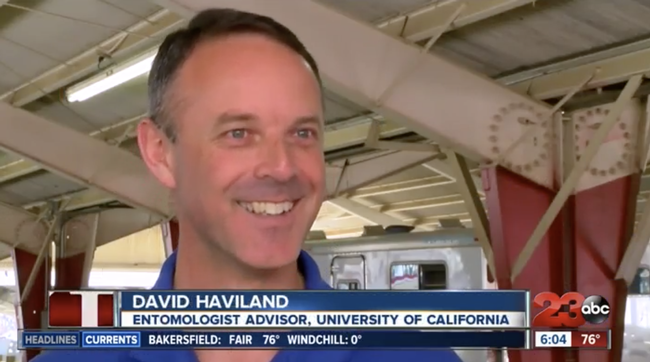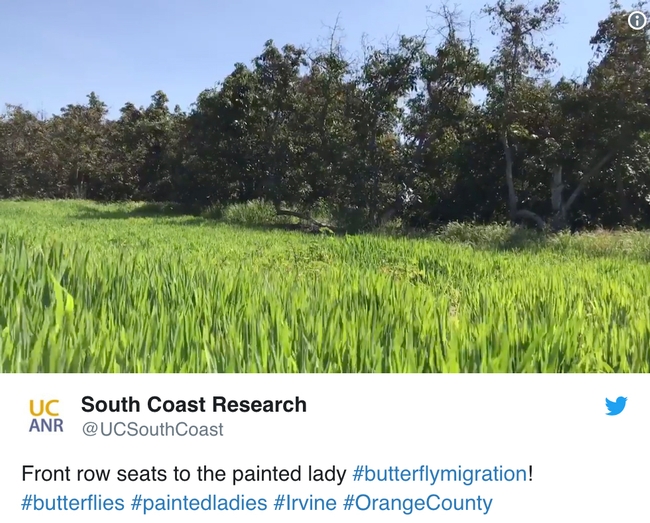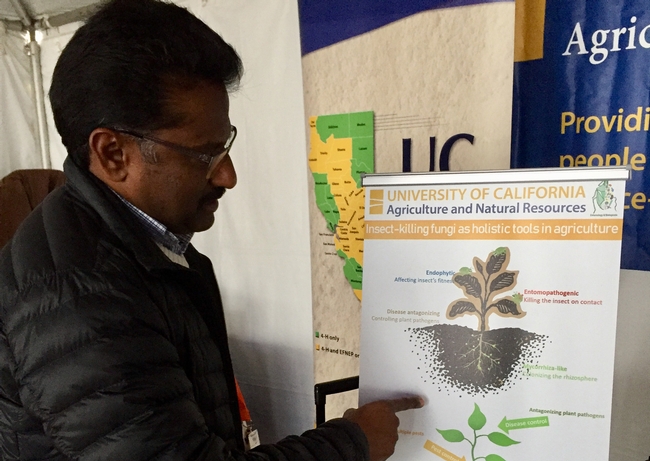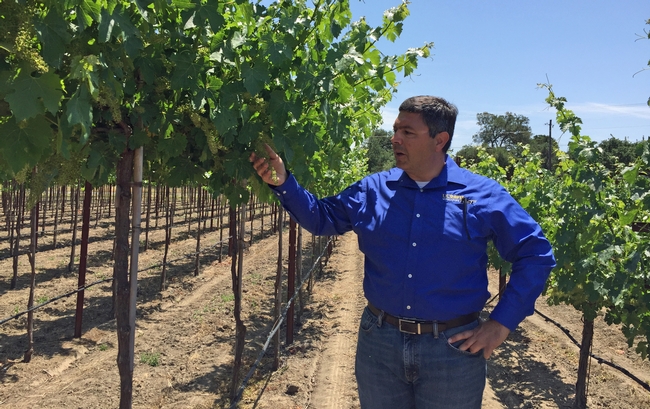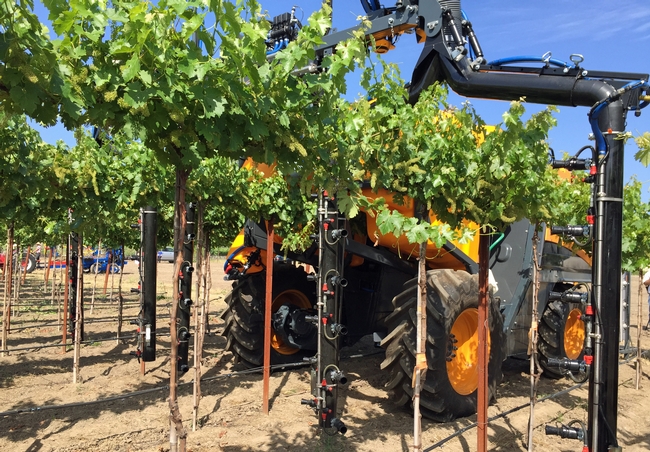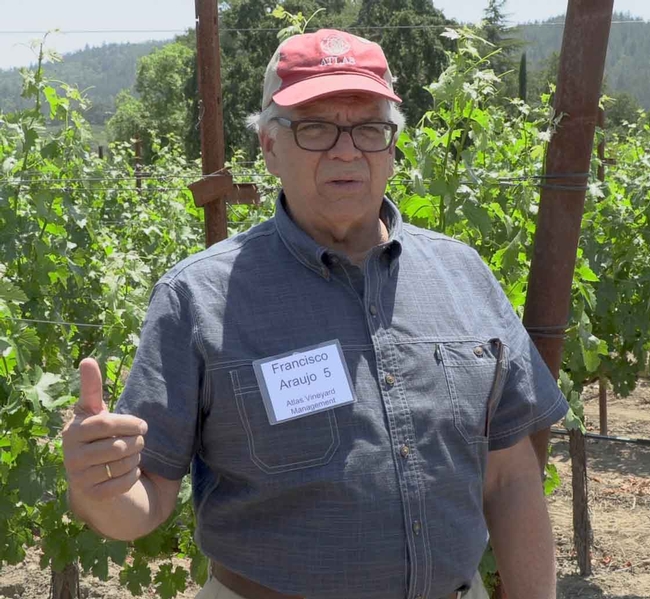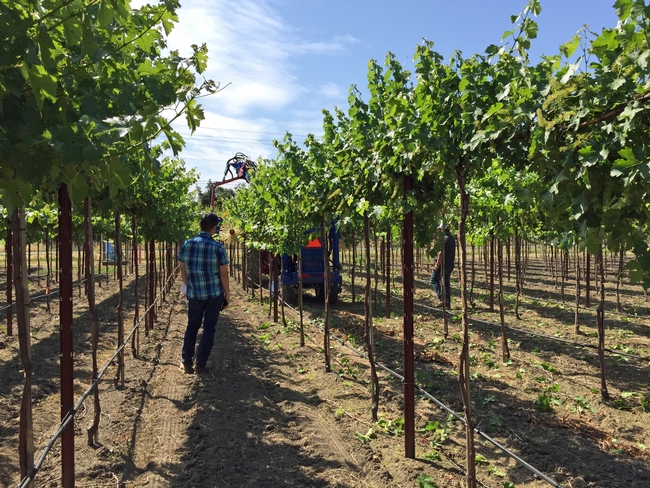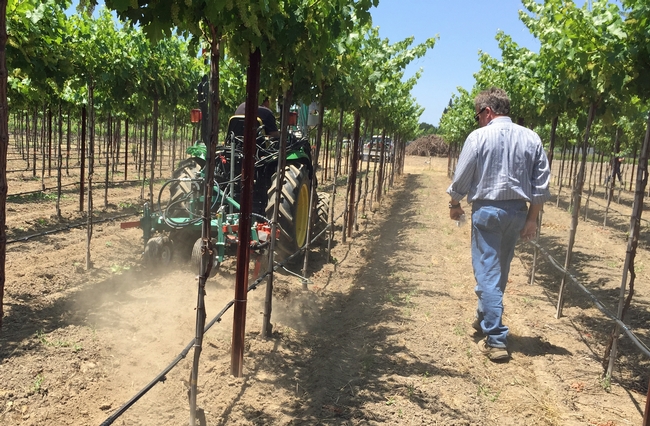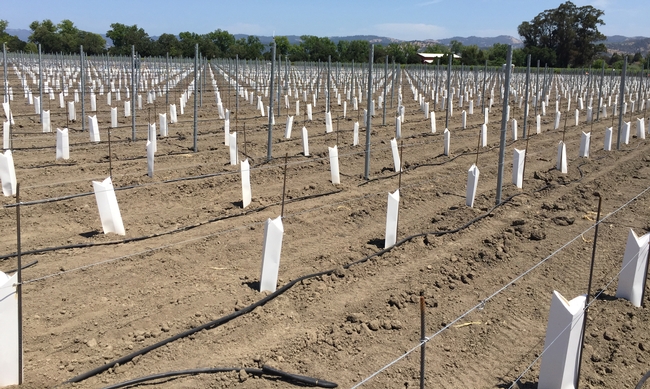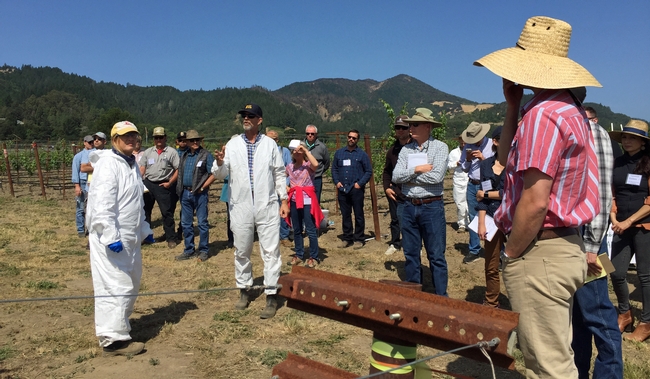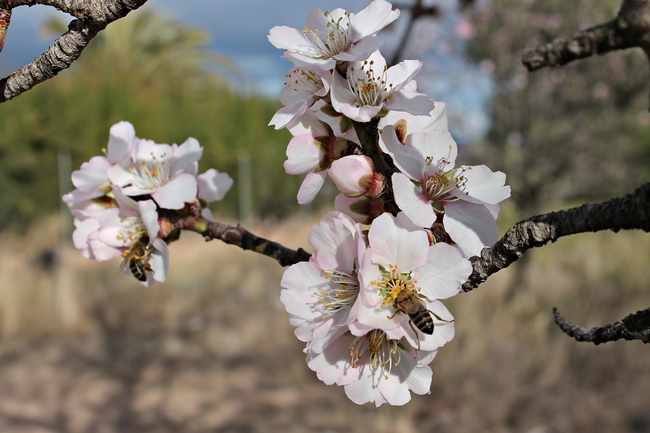Posts Tagged: Franz Niederholzer
ANR in the news March 13-28
New Series of Nitrogen Management Advice Available
(Cal Ag Today) March 28
California growers can download a new series of publications summarizing efficient nitrogen management practices from UC Agriculture and Natural Resources. The publications are designed to assist growers in complying with state regulations for tracking and reporting nitrogen fertilizer applied to crops, in an effort to prevent nitrogen from leaching into groundwater.
https://californiaagtoday.com/new-series-of-nitrogen-management-advice-available
UC helps growers comply with new regulations
(Farm Press) Tim Hearden, March 27
A few months ago, while I was working with Todd Fitchette on a special package we were doing (or, he was doing and I was pitching in on) that focused on the 50th anniversary of the Citrus Research Board, I wrote a column about the benefits of land-grant universities such as the University of California (UC).
It's not an overstatement, I wrote, that the vast network of UC Cooperative Extension offices and research facilities has enabled agriculture in the Golden State to survive amid daunting challenges.
https://www.farmprogress.com/commentary/uc-helps-growers-comply-new-regulations
Communities come together to reforest Middletown Trailside Park
(Record Bee) Lucy Llewellyn Byard, March 27
Outdoorsman Greg Gusti, a University of California cooperative extension director emeritus who specializes in forests and wild lands ecology, addressed the crowd and gave them instructions on how to plant the trees 20 feet apart; showed them what 20 feet looked like on a tape measure, told them to plant the green side up and to keep the roots straight.
… Students dug in groups, sharing shovels and gloves. Sofie Hall and Elissa Holyoke worked with Michael Jones, a UC Cooperative Extension Forestry Advisor to plant their saplings.
The science and politics of genetically engineered salmon: 5 questions answered
(The Conversation) Alison Van Eenennaam, March 27
A Massachusetts-based company earlier this month cleared the last regulatory hurdle from the Food and Drug Administration to sell genetically engineered salmon in the U.S. Animal genomics expert Alison Van Eenennaam, who served on an advisory committee to the FDA to evaluate the AquAdvantage salmon, explains the significance of the FDA's move and why some have criticized its decision.
https://www.sfchronicle.com/news/article/The-science-and-politics-of-genetically-13719679.php
Students learn about insects at Farm Day in the City
(ABC 23) Amanda Mason, March 26
"Every single insect plays a role, even if it's only purpose is to get eaten by something. Everything is important," said Haviland.
David Haviland an entomologist at the University of California's Extension who studies insects and helps farmers manage agricultural pests, spent Tuesday at the Kern County Fairgrounds teaching students about good bugs and bad bugs at Farm Day in the City.
https://www.turnto23.com/homepage-showcase/students-learn-about-insects-at-farm-day-in-the-city
Expert: Speak up now about agriculture's carbon footprint
(Leader Telegram) Brooke Bechen, March 25
Dr. Frank Mitloehner, a professor and air quality extension specialist in the Department of Animal Science at the University of California-Davis, isn't afraid to speak up, particularly on Twitter where he writes under the handle @GHGGuru. He sees 2.5 million people visiting his Twitter account each month, which provides accurate information on air emissions and busts myths distributed by those looking to attack animal agriculture.
“Being in California is like being at Ground Zero,” he said. “There are urban centers of people who think they're food experts, but most of these people have never set foot on a farm and don't know anything about agriculture.
Wildfire Speaker Series Tonight: Fire Resistant Homes & Defensible Space
(YubaNet) March 25
…Dr. Kate Wilkin is the new Forest and Fire Adviser with UC Cooperative Extension in Butte, Nevada, Sutter, and Yuba Counties. She recently moved here from Berkeley, CA where she was postdoctoral researcher focused on wildfire emissions and fire-forest-water relations. Her PhD, also at UC Berkeley, focused on the efficacy of fuel treatments in Northern California shrublands to reduce fire hazards and on mixed conifer forest-fire-water and fire-biodiversity relations. Before moving to California, Kate grew up in rural Appalachia and then explored other fire-prone regions of the US as a natural resource manager and prescribed fire burner on public and nonprofit lands. Based on these experiences and more, she knows that we need to use solutions responsibly, both old and new, to solve our forest health crisis. Kate will be focusing on incorporating fire safe concepts into residential landscaping.
https://yubanet.com/regional/wildfire-speaker-series-tonight-fire-resistant-homes-defensible-space
UC Cooperative offers water-measurement class
(David Enterprise) March 25
California water rights holders are required by state law to measure and report the water they divert from surface streams. For people who wish to take the water measurements themselves, the University of California Cooperative Extension is offering training to receive certification April 4 in Redding and Woodland.
Costa Mesa designates April as Coyote Awareness Month and approves further informational efforts to manage them
(Los Angeles Times) Luke Money, March 20
…In the past 30 days, about 20 coyote sightings or encounters in Costa Mesa were logged with Coyote Cacher, an online reporting system [created by Niamh Quinn, UCCE advisor, and IGIS].
https://www.latimes.com/socal/daily-pilot/news/tn-dpt-me-cm-coyote-plan-20190320-story.html
UCCE Biologicals Conference Introduces New Crop Protection Tools for Growers
(Vegetables West) Matthew Malcolm, March 19, 2019
Biocontrol agents, beneficial microbes, entomopathogenic fungi and bacteria that can enhance crop production — these were all topics of discussion at the recent UC Cooperative Extension Ag Innovations Conference in Santa Maria, led by UCCE Entomology & Biologicals Advisor Surendra Dara. Watch this brief interview with Surendra as he shares more about what was discussed.
Landowners aim to fight fire with fire
(Benito Link) Blaire Strohn, March 19, 2019
The 2018 wildfire season in California was devastating, which left local landowners to consider how future blazes can be prevented. Their solution: more fire.
On March 14, The San Benito Working Landscapes Group and the UC Cooperative Extension (UCCE) hosted a meeting to discuss prescribed burning on San Benito County rangelands.
…UCCE livestock and natural resources advisor Devii Rao said the meeting also looked at Cal Fire funding and prescribed burn associations. She mentioned that last year former Gov. Jerry Brown signed two pieces of legislation related to prescribed burning:
Senate Bill 901 provides Cal Fire $1 billion for forest health, fuel load, and prescribed burns over five years, including $35 million a year for prescribed fire and other reduction projects.
Senate Bill 1260 requires Cal Fire to collaborate with public and private landowners on prescribed burns. They must also create a program for pre-certification for a “burn boss,” a private contractor that has experience in prescribed burning.
…In June, Rao will co-host a meeting with Lenya Quinn-Davidson and Jeff Stackhouse from UCCE Humboldt County. The meeting is expected to focus on how to develop a prescribed burn association, in addition to a small burn demonstration on a local private ranch.
https://benitolink.com/news/landowners-aim-fight-fire-fire
A More Humane Livestock Industry, Brought to You By Crispr
(Wired) Gregory Barber, March 19
Hopes were running high for cow 401, and cow 401 serenely bore the weight of expectations. She entered the cattle chute obligingly, and as the vet searched her uterus, making full use of the plastic glove that covered his arm up to his shoulder, she uttered nary a moo. A week ago, Cow 401 and four other members of her experimental herd at UC Davis were in the early stages of pregnancy. But now, following a string of disappointing checkups, it was all down to her. Alison Van Eenennaam, the animal geneticist in charge of the proceedings, kept watch from off to one side, galoshes firmly planted in the damp manure, eyes fixed on a portable ultrasound monitor. After a few moments, the vet delivered his fifth and final diagnosis. “She's not pregnant,” he said. Van Eenennaam looked up. “Ah, shit,” she muttered.
https://www.wired.com/story/crispr-gene-editing-humane-livestock
Climate change is hurting migrating waterbirds across the West. It could get worse
(Sacramento Bee) Andrew Sheeler, March 18
…Some birds, like the black-necked stilt and the sandhill crane, which breed early in the season, have thrived in the warming climate, said Mohammad Safeeq, a hydrologist with the Sierra Nevada Research Institute and an adjunct professor at UC Merced.
But others suffer. That includes the killdeer, the Wilson's snipe, the black tern, and the western and Clark's grebe.
“We have looked at 14 species and among eight open-water and shoreline foraging species that have undergone significant population declines, five were negatively associated with temperature increases,” Safeeq said in an email interview.
https://www.sacbee.com/news/local/environment/article227983859.html
Group seeks healthy, resilient forests and communities
(Plumas News) March 18
…A public workshop was held at the Quincy Library on Jan. 15th. Presenter Jeff Stackhouse, the Livestock and Natural Resources advisor for the U.C. Cooperative Extension in Humboldt, presents case studies from the prescribed burn association.
http://www.plumasnews.com/group-seeks-healthy-resilient-forests-and-communities
US researchers moving abroad to avoid FDA's CRISPR-edited animal regulations
(Genetic Literacy Project) Cameron English, Alison Van Eenennaam, March 14
One day soon, farmers may be able to raise food animals immune to deadly diseases and spare them painful but necessary procedures like horn removal. These innovations, made possible by CRISPR and other gene-editing techniques, could cut the cost of food production, reduce antibiotic use in agriculture and dramatically improve animal welfare. But federal regulation may very well stifle these developments in the US.
In 2017, the Food and Drug Administration (FDA) proposed a plan to regulate gene-edited animals as veterinary drugs under the 1938 Food, Drug and Cosmetic Act, because their DNA is “intentionally altered.” The proposal has drawn harsh criticism from animal scientists, some of whom are packing up their labs and leaving the US to avoid the FDA's rules. Food animals, these experts say, should be regulated based on the risk they pose to human health, not the breeding method that produced them.
Corky Anderson's energy, innovation helped save California's pistachio industry
(Bakersfield Californian) Steven E. Mayer, March 13
"Corky was an important player in the early pistachio industry," said a Kern County farm adviser with the UC Cooperative Extension who specializes in citrus and pistachios.
"And he was a great cooperator," Kallsen said. "He allowed lots of test trials on his properties."
… In 1980, Anderson and Puryear's first patented rootstock changed the industry, said Kevin Blackwell, general manager of Pioneer Nursery, the wholesale business founded by the two entrepreneurs.
"In our heyday, we were selling a million trees a year," said Blackwell, who said he has known Anderson for 47 years.
No one does it alone, Kallsen noted. Anderson built and refined his patented rootstock based on earlier research by the University of California.
Farmers protect crops in rain's aftermath
(Ag Alert) Ching Lee, March 13
Franz Niederholzer, University of California Cooperative Extension farm advisor in Colusa, Sutter and Yuba counties, said though cold weather does reduce the risk of most fungal diseases, other problems such as bacterial blast and jacket rot—also a fungal disease—are more prevalent during cool weather.
Cooler weather, however, does help to extend the bloom, he said. That allows farmers more time to apply fungicide, which is recommended at the beginning of bloom and again at full bloom, he said.
Brent Holtz, UCCE farm advisor in San Joaquin County, said he hasn't seen too many problems with fungal diseases at this point, because of how cool it's been, but there have been more incidents of bacterial blast, which can infect trees under stress. In orchards with high nematode populations, the bacteria can enter wounds on the surface of the plants created by frost, he noted.
"It blights the blossoms, and if the blossom is dead, they don't produce fruit," Holtz said.
http://agalert.com/story/?id=12801
Michael learns about 4-H in Fresno County
(KMPH) Stephen Hawkins, March 13, 2019
The 4-H Youth Development Program is preparing for events all over the Central Valley and you are invited.
Michael Ikahihifo spent the morning at Dry Creek Park in Clovis to see what the local 4-H has planned.
https://kmph.com/great-day/michael-in-the-mix/michael-learns-about-4-h-in-fresno-county
The City of Cypress calls for its residents to be “Coyote Aware”
(OC Breeze) March 13
The Cypress City Council recently adopted a coyote management plan to address community concerns about the presence of coyotes in Cypress. While coyotes are generally reclusive animals who avoid human contact, it is important to be aware of their presence and take appropriate action to ensure the safety of your property and pets.
…Residents are encouraged to reportcoyote activity on Coyote Cacher:
Coyote Cacher allows the City to monitor all reported encounters.
Residents can also use Coyote Cacher to view a map of reported
encounters and sign up to receive email alerts.
California's super bloom attracts swarms of migrating butterflies
(CNN) David Williams, March 13
This year's wildflower super bloom is not only filling California deserts with eye-popping displays of color -- it's also providing a feast for swarms of painted lady butterflies making their way north from Mexico.
"This is the biggest outbreak since 2005," said Art Shapiro, a professor at the University of California, Davis, who's been studying the migration of butterflies in the state since 1972.
…"I saw more butterflies in the last 10 minutes than I've seen my entire life," Jason Suppes wrote Tuesday on Twitter. Suppes is an education specialist at an agricultural research facility in Irvine.
http://edition.cnn.com/travel/article/california-butterflies-trnd/index.html
Grape growers continue push to mechanize
(Western Farm Press) Lee Allen, March 13
…In Fresno, growers affiliated with the San Joaquin Valley Winegrowers Association met to discuss the latest UC research on incidents of disease and machine injury to trunks and rootstock.
… “Growers are having a hard time finding workers to maintain their vineyards and increasing labor costs are challenging grape-farming's economic sustainability,” says UC Cooperative Extension viticulture advisor George Zhuang. “We're studying the use of machines to reduce the number of people needed to perform tasks like pruning.
“Because canopy architecture and yield characteristics involving mechanically-pruned vines are much different from those that are hand-pruned, water and fertilizer requirements for the mechanically pruned vines can be quite different. Performance of different rootstocks in mechanical pruning systems is critical for both yield and fruit quality of grape production in the San Joaquin Valley.”
…Kaan Kurtural, UC Cooperative Extension viticulture specialist in the UC Davis Viticulture and Enology Department, whose research involves improving vineyard production efficiency through canopy and crop load management via mechanization, says the case for switching out hand labor with machines gets stronger with growers using such mechanization for pruning, suckering, and removing shoots and leaves.
“Mechanical pruning can produce more stable year-to-year fruit yields of better quality than traditional and more costly hand pruning spurs or canes.” His comments were based on a Kern County two-year research trial looking for ways for growers to reduce both cost and water use.
https://www.farmprogress.com/grapes/grape-growers-continue-push-mechanize
As Wildfires Devour Communities, Toxic Threats Emerge
(Reuters) Sharon Bernstein, March 13
At U.C. Davis, where researchers are studying eggs from backyard chickens that may have breathed smoke and pecked at ash in areas affected by wildfires, the work is complicated.
"In an urban fire you're dealing with contaminants that don't go away – arsenic, heavy metals, copper, lead, transformer fluid, brake fluid, fire retardant," said veterinarian Maurice Pitesky, who is leading the study.
https://www.usnews.com/news/us/articles/2019-03-13/as-wildfires-devour-communities-toxic-threats-emerge
DR. GLENDA HUMISTON: Managing our Lands to Manage our Water
Maven's Notebook, March 13, 2019
Dr. Glenda Humiston is Vice President of Agriculture & Natural Resources for the University of California. At the 2019 California Irrigation Institute conference, Dr. Humiston was the opening keynote speaker, and in her speech, she talked about work being done to address drought vulnerability, the importance of managing watersheds, the goals of the California Economic Summit, and the promising future of biomass.
She began by saying that we have known for a long time that water insecurity is a huge issue, and not just due to climate change or droughts; it's also policy, regulations, allocations and technology – there are a lot of issues and managing the effects of it are very challenging.
https://mavensnotebook.com/2019/03/13/dr-glenda-humiston-managing-our-lands-to-manage-our-water/
Hearing planned to examine the future of development in California's most fire prone regions
(Lake County News) March 13
…The hearing, led by Senators Henry Stern and Mike McGuire, chair of the Senate Natural Resources and Water Committee and the Senate Governance and Finance Committee, respectively, titled “Living Resiliently in the New Abnormal: The Future of Development in California's Most Fire Prone Regions” will be held Wednesday at 9:30 a.m. at the State Capitol in Room 4203.
…Testifying at the hearing are:
· Mark Ghilarducci, director, California Office of Emergency Services;
· Bob Fenton, regional administrator, FEMA Region 9;
· Dr. Max Moritz, statewide wildfire specialist, University of California Cooperative Extension;
· Jeff Lambert, director of planning, city of Oxnard, past president, American Planning Association, California Chapter;
· Chief Kate Dargan, California State Fire Marshal (retired), Cal Fire;
· Chief Ken Pimlott, director (retired), Cal Fire;
· Scott Lotter, former mayor, city of Paradise;
· Tim Snellings, planning director, Butte County;
· Chief Michael McLaughlin, Cosumnes Community Services District Fire Department;
· Ty Bailey, California Professional Firefighters, president, Sacramento Area Firefighters, Local 522, fire captain, Sacramento Metropolitan Fire District.
ANR in the news March 1-11
Western Innovator: Putting biologicals to work
(Capital Press) Padma Nagappan, March 11
Early in life, Surendra Dara decided that no matter which field he chose, he needed to make an impact on it. Always interested in science, he chose agriculture and specialized in entomology.
“It attracted me because it dealt with arthropods and there are a lot of physiological similarities to the human world,” Dara said. “It was also critical for growing food and feeding humans.”
Dara is now an entomopathologist with the University of California's Division of Agriculture and Natural Resources in San Luis Obispo, and has an established reputation for exploring innovative options to control pests using microbials as biological controls, and showing growers how they can also help with plant growth, drought resistance and fighting diseases.
Group linked to Ocasio-Cortez seeks ag input after Green New Deal backlash
(Politico) Helena Bottemiller Evich, March 11
After watching that drama unfold, Frank Mitloehner, a leading scientist on agricultural emissions at the University of California, Davis, was thrilled when two outreach staff affiliated with AOC's network reached out to set up a call to discuss the potential for climate mitigation efforts in agriculture. The call, held earlier this month, lasted more than an hour, Mitloehner said.
“I was very glad to inform of what I know, and they were very receptive to it,” Mitloehner said on Agri-Talk last week. During the segment, he urged agricultural producers to not dismiss the left-wing climate effort.
Sudden surge in an unusual crime in Fresno County: Goat theft
(LA Times) Hannah Fry, March 11, 2019
…Picquette's two sons have been raising goats for the last five years as a 4-H project. Losing their animals has been especially hard for the boys, Picquette said, adding that they had planned to use money won during competitions to pay for college.
“They feel very violated. They don't understand how somebody could just come and take something they worked so hard for,” she said. “The bond we have with the goats is incredible. I'm just heartbroken. I don't know if they're scared or hungry. … They've always been treated so well.”
https://www.latimes.com/local/lanow/la-me-ln-fresno-goat-theft-20190311-story.html
California's ambitious plan to stop deadly wildfires may not be enough, experts say
(SF Chronicle) Kurtis Alexander, March 9
… “It's not fair to say that fuel treatments won't do any good,” said Max Moritz, a UC Cooperative Extension wildfire specialist at UC Santa Barbara. “It may provide some protection in some places. But most of us studying this agree that you can't just do this and (expect to) make much headway.”
The plan by the California Department of Forestry and Fire Protection, or Cal Fire, comes at the request of Gov. Gavin Newsom. On his second day in office, Newsom asked the agency to develop a proposal to address the increasingly destructive fire seasons that have rattled the state and are expected to worsen with climate change.
…In the meantime, many researchers say the most effective approach to fire protection is not in the forests, but in communities. They recommend making homes more resistant to fire with hardier construction materials, and clearing the vegetation around them.
“You have to address the home vulnerabilities themselves,” said Moritz at UC Santa Barbara. “If you don't, you're just not going to make a lot of progress on fire.”
After more than 140 years, a massive fig tree gracing the plaza where Los Angeles was founded collapses
(LA Times) Matthew Ormseth, March 9
… The four figs were planted at El Pueblo by agriculturalist and City Councilman Elijah Hook Workman, KCET reported in 2013. The Ficus macrophylla was brought from Australia to Southern California in the 1860s and 1870s, probably to provide shade and ornamentation, said Donald Hodel, a horticulture advisor for the University of California's Cooperative Extension.
Hodel described the Moreton Bay fig as a commanding breed of tree with an enveloping canopy that threw plenty of shade.
His reasons for admiring the Moreton Bay fig: “Their grandeur; their size — they have an imposing habit; their root structure is incredible; the spreading nature of their branches.”
Hodel said he last saw the El Pueblo figs about six years ago.
“I wasn't too impressed by their health or their size, considering they're 140-something years old,” he said.
https://www.latimes.com/local/lanow/la-me-pueblo-tree-falls-20190309-story.html
California's 2018 Was the Worst Ever Recorded for Wildfires
(Gizmodo) Tom McKay, March 9
University of California, Santa Barbara UC Cooperative Extension wildfire researcher Max Moritiz told the Chronicle, “It's not fair to say that fuel treatments won't do any good. It may provide some protection in some places. But most of us studying this agree that you can't just do this and (expect to) make much headway.”
https://earther.gizmodo.com/californias-2018-was-the-worst-ever-recorded-for-wildfi-1833180368
4-H leader who taught lost Benbow girls outdoor skills being flown to Washington, DC for recognition
Kym Kemp, March 7
When Leia Carrico, age 8, and her sister, Caroline, age 5, disappeared into the woods around their home near Benbow on March 1, the whole nation held its breath for the next 44 hours until they were found. But, though their 4-H leaders were worried, too, they say they also knew the girls had something many other children don't–they had survival skills from a class taught by their Outdoor Adventures 4-H project leader, Justin Lehnert.
Lehnert is being honored in Washington, DC, on Tuesday for his role in teaching Leia and Caroline outdoor skills.
Researchers highlight plan to eat healthy on a budget
(Consumer Affairs) Kristen Dalli, March 7
Following a healthy diet can come with a hefty price tag, but a team of researchers has outlined a way for consumers to stick to a healthy diet -- and also stick to their budgets.
According to the team, consumers -- and their families -- can have healthy meals if they focus on buying items in bulk and planning meals in advance.
“This study determines the likelihood that families living in low-income households could create meals that meet the USDA dietary guidelines presented in MyPlate nutrition education materials,” said researcher Karen M. Jetter, PhD. “In addition to food cost, the other factors considered were access to stores, time for meal preparation, and whether the menus included culturally appropriate foods.”
Healthy eating is possible on a limited budget, study shows
Study: Eating healthy on a budget is possible
https://www.upi.com/Study-Eating-healthy-on-a-budget-is-possible/9951551904010/
Eating Healthy Is Possible on a Small Budget, Says Study
https://www.askmen.com/news/sports/eating-healthy-is-possible-on-a-small-budget-says-study.html
Sorry, Alexandria Ocasio-Cortez, but “farting cows” aren't the problem
(New Food Economy) Sam Bloch, March 7
…As it turns out, neither side was accurate. Republicans are likely to continue linking Green New Deal priorities to a supposed hamburger ban. But if you don't hear about cow farts anymore from AOC, it may not be because of GOP criticism. Frank Mitloehner, an animal scientist and air quality specialist at the University of California, Davis, insists cattle flatulence isn't the problem it's made out to be, and says he helped set the record straight.
Here's what seems to have happened. On February 4, shortly before Ocasio-Cortez announced the Green New Deal, she was speaking to school children in Queens, New York. When one asked how they could “combat” climate change, Ocasio-Cortez offered two practical options—stop using disposable razors, and skip meat and dairy for one meal.
Mitloehner tweeted at her.
“Dear @AOC: we all try to help the climate,” he wrote. “However, the two options you offered have low impacts compared to the 800lb gorilla, which is to reduce fossil fuel use. About ? of greenhouse gas emissions in the US stem from transport and energy prod&use. Meat/milk = 4 % of total GHG,” referring to findings in a recent EPA report.
… “I give her team a lot of credit for reaching out,” Mitloehner says. “If we really are serious about making a difference in carbon emissions, you cannot do this without agriculture involved.”
California supplies a quarter of the world's sunflower seeds
(Capital Press) Padma Nagappan, March 7
…Khaled Bali is a University of California Department of Agriculture and Natural Resources statewide water and irrigation specialist who has been working since 2016 on a four-year trial on sunflower varieties.
He was asked by the University of Georgia to help ascertain which varieties were drought resistant. He chose to conduct his trial in the low desert region of the Imperial Valley, since it gets little rain during the growing season between February when it's planted, and June when it's harvested. This would make it easier to control and measure the actual water applied to the crop varieties.
“We're looking at 285 varieties of sunflowers, to see which ones do well under stress,” Bali said. He has tested different plantings each growing season for the past three years, and will finish the trial this year.
https://plantingseedsblog.cdfa.ca.gov/wordpress/?p=17375
Livestream coverage of fire protection panel discussion in Nevada City
(Sierra Sun) March 7
…Following the films, the community is invited to join an ongoing conversation around the new reality of living with fire in the wildland urban interface. Panelists represent a diverse cross-section of the wildfire prevention community including: Cal Fire, Fire Safe Council of Nevada County, Nevada County Office of Emergency Services, Nevada County Resource Conservation District, Pacific Gas and Electric Company, Tahoe National Forest and University of California Cooperative Extension. The panel discussion will be moderated by YubaNet Co-founder Pascale Fusshoeller. [Kate Wilkin, UCCE fire advisor, participates on the panel in the last hour of the video.]
Bees, blooms off to slow start
(Western Farm Press) Logan Hawkes, March 6
…This year, almond bloom started around a normal time, with some early varieties showing a few open flowers in the first week of February,” reported Franz Niederholzer, UCCE farm advisor for Colusa, Sutter, and Yuba Counties. “For most of the month bloom progressed very slowly,”
By the middle of February, he says, “bloom for Nonpareil was at least two weeks behind, and bee hours were limited until the last week of the month. Last year, between Feb 1-20, we accumulated 130 bee hours of good honey bee flying weather [55 F., no rain, and wind less than 10 mph]. For the same interval this year, we had around 10 hours and only six of those occurred with open flowers in the orchard.”
On the positive side of the slow start, Niederholzer says, the colder weather tends to suppress activity of key bloom diseases such as blossom brown rot and anthracnose. “However, cold weather at bloom was conducive to blossom blast (pseudomonas) bacteria, and some growers were considering adding materials to their normal bloom fungicides with bactericide activity.”
https://www.farmprogress.com/tree-nuts/bees-blooms-slow-start
Wet winter aids groundwater replenishment
(Ag Alert) Christine Souza, March 6
… Helen Dahlke, a hydrology expert and professor with the University of California, Davis, Department of Land, Air and Water Resources, has been working with farmers, studying on-farm groundwater recharge locations and suitability for various crops.
"In many regions, we can definitely do more actively recharging our groundwater aquifers," said Dahlke, who currently has trials on alfalfa at the UC Kearney Agricultural Center. "It really depends on what region, how much surface water is available for recharge, what kind of sediment structure or hydrogeology we have underneath and whether it's suited for conveying large amounts quickly."
Despite abundant precipitation in recent weeks, she said the timing is not the best for studying impact of recharge on certain crops.
"We prefer on-farm recharge to happen in January and February, just because that is considered the dormancy season for most crops," Dahlke said. "With almond trees already blooming, often there is a greater risk of applying water on those crops."
She said recent precipitation has helped groundwater recharge overall, but there is "very little way of estimating how much it is helping."
http://www.agalert.com/story/?id=12797
Drip irrigation improves yields of Imperial sugar beets
(Ag Alert) Padma Nagappan, March 6
Halfway through a two-year irrigation trial to test furrow irrigation versus drip on sugar beet in California's Imperial Valley, Ali Montazar is looking for ways to boost yields with as little water consumption as possible in a region where furrow irrigation is the common practice.
Montazar, irrigation and water management advisor with the University of California department of agriculture and natural resources (UCANR) in Imperial County, is comparing and evaluating sugar beets for crop water use, sugar percentage, and yield, using both furrow and drip, since growers are now thinking of switching to subsurface drip.
Preliminary results from year one of the trial show that yield and crop water use are better with drip. Yield was 21 percent higher, and water use was a few points lower.
http://www.agalert.com/story/?id=12782
NFU says “No” to Green New Deal
(DTN) Jerry Hagstrom and Chris Clayton, March 6
Frank Mitloehner, an animal-science professor and air-quality Extension specialist at the University of California-Davis, reached out to Ocasio-Cortez's team about agriculture and the Green New Deal after seeing social media posts late last month about “farting cows” that drew a great deal of attention.
“I appreciate her interest in climate-change mitigation, but the 800-pound gorilla is the use of fossil fuels, and I told her that even the notion of cow flatulence makes this whole thing sound silly, and that's not what we need this discussion to be,” Mitloehner told DTN in an interview.
From Farting Cows to More Beans; Anti-Livestock Claims Fall Short
(AgriTalk) Jennifer Shike, March 5
The EAT-Lancet Commission on Food, Planet, Health is backpedaling as industry leaders and scientists poke holes in its “planetary diet” released in mid-January that is supposed to improve human health and planet health.
Air Quality Extension Expert Frank Mitloehner of the University of California Davis joined Chip Flory on AgriTalk Monday to discuss EAT-Lancet and Green New Deal in more depth.
4-H instructor who taught NorCal sisters how to survive in wilderness speaks out
(ABC7) Dion Lim, March 4
ABC7 News spoke exclusively to the 4-H instructor who taught two young girls the life-saving skills they needed to survive a weekend lost in the woods.
… Their mom, Misty Carrico, says she's not sure her daughters would have survived, if not for their 4-H program.
"The group leader Justin has taught them fire making skills and wilderness survival skills."
Justin Lehnert, the girls' 4-H leader, said, "I'm ecstatic that they did the job that they did. They're very strong girls and they stayed calm."
… Nine-year-old Caroline Gelormini has been a member of the San Bruno-South San Francisco 4-H Program for five years. Thanks to 4-H, she feels like she'd have a shot at surviving in the woods too.
Ocasio-Cortez Seeks Ag Data on Green New Deal
(Drovers) John Herath, March 4
When freshman congresswoman Alexandria Ocasio-Cortez released her Green New Deal plan, social media lit up with talk of her plan's mentions of “farting cows.” That drew the attention of agriculture's preeminent expert on air quality, Dr. Frank Mitloehner of the University of California at Davis, who tweeted back at the congresswoman.
“I don't know whether my tweet was the reason, but a few hours after I tweeted her, all mentioning of cow flatulence were taken off the web pages and of all social media outlets and was never to be heard again,” Mitloehner told Chip Flory on the AgriTalk Radio Show Monday.
https://www.drovers.com/article/ocasio-cortez-seeks-ag-data-green-new-deal
2 missing Humboldt County girls found — ‘absolute miracle
(SF Chronicle) Michael Cabanatuan, March 3
…Little additional information was available on how the girls went missing or how they survived, but Honsal said they had been trained in outdoors survival as members of a 4-H program.
https://www.sfchronicle.com/news/article/Absolute-miracle-as-missing-Humboldt-County-13659375.php
Organic farm east of Denair does its part on climate change. It's getting an award
(Modesto Bee) John Holland, March 2
…The family won in the farmer/rancher category of the Climate Leadership Awards. The others:
- Researcher: Tapan Pathak of the University of California Cooperative Extension in Merced, who helps farmers adapt to climate change.
- Policymaker: Ken Alex, who was director of former Gov. Jerry Brown's Office of Planning and Research
- Legislative staff: Brett Williams, office of Assemblywoman Jacqui Irwin, D-Thousand Oaks
- Agricultural professional: Ruth Dalquist-Willard, UC Cooperative Extension, Fresno
https://www.modbee.com/news/article226956529.html
Eructation Inflation: Greenhouse Gas Emissions of Livestock
(Science for the Rest of Us) March 1
Put your nerd hat on -- we cover a lot of ground in this fast-paced discussion with Dr. Frank Mitloehner of the University of California-Davis about the greenhouse gas emissions associated with the meat and dairy we consume. We consider how livestock emissions compare to other sectors of the US and global economies, the carbon footprint of vegetarian diets and what is the most effective way to reduce individual carbon emissions.
Keeping the Carbon Footprint of Livestock in Perspective
(AgNet West) Brian German, March 1
…“It is irresponsible and it's misguiding the public to believe that the true sources of pollution are downplayed, and the impacts of animal agriculture are grossly inflated,” said Dr. Frank Mitloehner, Professor and Air Quality Specialist in Cooperative Extension in the Department of Animal Science at the University of California, Davis.
August 2018 News Clips 8/1-8/15
UC: Tariffs could cost fruit, nut industries over $3 billion
(Farm Press) Aug. 15
A new report released by the University of California Agriculture and Natural Resources' Agricultural Issues Center estimates the higher tariffs could cost major U.S. fruit and nut industries $2.64 billion per year in exports to countries imposing the higher tariffs, and as much as $3.34 billion by reducing prices in alternative markets.
https://www.westernfarmpress.com/tree-nuts/uc-tariffs-could-cost-fruit-nut-industries-over-3-billion
Evacuation priorities: Save people first, then livestock
(Ag Alert) Kathy Coatney, Aug. 15
"It's generally too difficult to get trucks out on such a short notice," said Glenn Nader, University of California Cooperative Extension livestock and natural resources advisor emeritus for Butte, Sutter and Yuba counties.
… Carissa Koopmann Rivers, UCCE livestock and natural resources advisor for Siskiyou County, said the Klamathon fire, first reported in early July, devastated the town of Hornbrook, which is situated in a cattle-producing area.
…Ricky Satomi, UCCE forestry advisor for Shasta, Trinity and Siskiyou counties, said if there's a wildfire and a person has advanced notice, there are several things that can be done to save buildings before evacuating.
http://agalert.com/story/?id=12106
Tariffs Could Cost California Growers Billions
(Growing Produce) Christina Herrick, Aug. 15
A new study from the University of California Agriculture and Natural Resources' Agricultural Issues Center finds that tariffs on 10 fruit and tree nut exports alone are estimated to cost the U.S. $3.4 billion annually.
https://www.growingproduce.com/nuts/tariffs-cost-california-growers-billions/
Interior Secretary: Environmental policies, poor forest management to blame for wildfires
(Circa) Leandra Bernstein, Aug. 14
…"Together, poor land management, poor land use planning and the onset of climate change, we have created the perfect environment for the perfect firestorm in California. It's completely expected and it's going to get worse," explained Dr. Kate Wilkin, a fire scientist at the University of California Cooperative Extension.
Looming Chlorpyrifos Ban Has ‘Natural' Pesticide Makers Buzzing
(Bloomberg) Tiffany Stecker, Aug. 14
...Alternatives may be available, but they lack the punch of chlorpyrifos, which kills multiple pests at once, Beth Grafton-Cardwell, a scientist working with citrus farmers as part of the University of California Cooperative Extension, told Bloomberg Environment.
https://www.bna.com/looming-chlorpyrifos-ban-n73014481691/
Fierce and Unpredictable: How Wildfires Became Infernos
(New York Times) Jim Robbins, Aug. 13
…Triple-digit temperatures “preheat the fuels, and it makes them much more receptive to igniting,” said Scott L. Stephens, a fire ecologist at the University of California, Berkeley.
https://www.nytimes.com/2018/08/13/science/wildfires-physics.html
In California's new wildfire reality, facing the need for periodic fires to clear fuel
(SF Chronicle) Kurtis Alexander, Aug. 13
While misguided forest- management policies are just one reason that fire has become more devastating, a warming climate and more development in California's wildlands also contribute, making planned burning vital, said wildfire specialist Max Moritz with UC's Division of Agriculture and Natural Resources.
“We need to become more comfortable with fire as a tool,” he said. “Prescribed fire could do a lot of good, restoring these forests to healthy conditions and reducing the fire hazard.”
8/13/18 Trade Tensions
(NewsTalk 780 KOH) Jon Sanchez Show, Aug. 13
Daniel Sumner, director of the UC Agriculture Issues Center, discussed the impact of trade tariffs on agriculture and U.S. economy with Jon Sanchez
https://www.spreaker.com/user/10565136/sanchez0813
UCCE Manure Nitrogen Study Update in Dairy Feed Crops
(California Dairy Magazine) Aug. 10
It takes time for the nitrogen found in dairy manure water to become available to feed crops out in the field, and as dairy producers don't want to under or over fertilize their feed crops, the UC Cooperative Extension is conducting a research trial to find out more regarding how manure water interacts in the soil with plant root systems. Watch this brief interview UC Agronomy Advisor Nicholas Clark as he summarizes a recent presentation he shared at the Golden State Dairy Management Conference.
Trees vital as heat waves ravage Southland, experts and L.A. officials say
(Hub LA) Hugo Guzman, Aug. 10
…Researchers with the University of California Cooperative Extension are helping do just that. In partnership with the United States Forest Service, researchers there have launched a 20-year study to identify trees that can withstand higher temperatures and lower rainfall. Native trees such as the Catalina Cherry and Ironwood trees, along with imports like Ghost Gum and Acacia trees, could form the future of L.A.'s canopy.
http://www.hub-la.com/news/trees-heat-waves-ravage-southland-officials/
Elkus Ranch brings kids to nature
(Half Moon Bay Review) Max Paik, Aug. 8
“I think it's important that the children get to see what it takes to care for farm animals … from the cute to the somewhat smelly,” said Igor Lacan, environmental horticulture adviser with the University of California Cooperative Extension, which runs the ranch.
What These Wildfires Say About Climate Change
(OnPoint NPR) Eric Westervelt, Aug. 8
Guests
- Daniel Berlant, assistant deputy director of Cal Fire, the state's fire agency.
- Ryan Lillis, reporter for the Sacramento Bee. He has covered most of Northern California's fires for the last 12 years. (@Ryan_Lillis)
- Lenya Quinn-Davidson, area fire adviser with the University of California's Cooperative Extension, which works with counties and communities in the state on managing the threat of wildfires. Northern California coordinator of the California Fire Science Consortium. (@lenyaqd)
Michael Mann, professor of atmospheric science and director of the Earth System Science Center at
Pennsylvania State University. Co-author of "The Madhouse Effect: How Climate Change Denial is Threatening Our Planet, Destroying Our Politics, and Driving Us Crazy." (@MichaelEMann)
http://www.wbur.org/onpoint/2018/08/08/mendocino-complex-wildfires-california-climate-change
Drought may be increasing camel cricket numbers
(Farm Press) Tim Hearden, Aug. 8
A few years ago, University of California viticulture and pest management advisors noticed unusual leaf symptoms in certain Napa County hillside vineyards that were right next to oak woodlands.
As described by the UC Cooperative Extension's Monica Cooper and Lucia Varela, the feeding activity they noted in April 2015 resulted in a “lace-like” appearance to damaged leaves. Then last year, in March, they observed feeding damage to expanding buds.
… Where vineyards have come into play is when they were situated on hillsides next to oak woodlands and mixed species of white alders, madrone, California bay, and Douglas fir, according to Varela, a north coast integrated pest management advisor, and Rhonda Smith, a UCCE viticulture advisor.
https://www.westernfarmpress.com/grapes/drought-may-be-increasing-camel-cricket-numbers
Yes, humans have made wildfires like the Carr fire worse. Here's how.
(Washington Post) Sarah Kaplan, Aug. 8
…Many forests in the western United States are “fire adapted” said Scott Stephens, a fire ecologist at the University of California at Berkeley. Natural wildfires every 5, 10 or 20 years help clear debris from the forest floor and make room for stronger, healthier trees.
…Wildfires are as unstoppable as hurricanes, Stephens said — and much like hurricanes, increasingly inevitable as the climate changes. “But you could do a lot more when you're getting ready for fire to inevitably occur,” he said. By building with fire-safe materials, establishing buffer zones between ecosystems and communities, and better caring for forests before fire season starts, some of the destructiveness of fires could be mitigated, Stephens said.
The staggering scale of California's wildfires
(New York Times) Lisa Friedman, Jose A. Del Real, Aug. 8
…Lisa: Mr. Trump in his tweet referred to the longstanding dispute between California farmers and environmentalists over the allocation of the state's precious water resources. Both sides want more and Mr. Trump has embraced the arguments of the agriculture community.
But William Stewart, a forestry specialist at the University of California, Berkeley said leaving less water for fish would have no impact on amount available for fighting fires. That water comes from local streams and rivers, where water-dropping helicopters drop their buckets. Neither he nor other scientists could point to a scenario in which California's environmental laws have prevented or curbed the use of water to fight wildfires.
https://www.nytimes.com/2018/08/08/us/california-today-fires-and-climate.html
California giving out $170 million in cap-and-trade revenue to help prevent wildfires
(San Francisco Chronicle) Kimberly Veklerov, Aug. 8
…Groups in six Bay Area counties will get a combined $7.4 million. The biggest portion of that, $3.6 million, will go to UC Berkeley. The Federal Emergency Management Agency in 2016 withdrew what would have been an award of roughly the same amount to thin and remove eucalyptus trees in the East Bay hills after a lawsuit by conservation activists.
…Keith Gilless, chairman of Cal Fire, said the state needs to do much more vegetation management — activities like reducing hazardous plant fuels — to address wildfire risk.
“One of the things we need in California moving forward is striking a better balance between carbon sequestration in forests and the risk associated with that densely stocked carbon sequestration,” said Gilless, also a UC Berkeley professor of forest economics. “We need to figure out ways to do vegetation management that are socially acceptable with the smallest public subsidy possible.”
These California counties have the highest concentration of homes vulnerable to wildfire
(Sac Bee) Michael Finch II, Aug. 7
In the case of the northern counties, the risk will be higher because homes there often dispersed at the edge of a wildland area, said Lenya Quinn-Davidson, a Eureka-based fire advisor for the University of California Division of Agriculture and Natural Resources.
“Those areas that you mentioned are areas that have a lot of homes mixed into the wildland-urban interface — areas where there are a lot of homes that are edgy and in the forest and have a lot of fuel.”
https://www.sacbee.com/news/state/california/fires/article216076320.html#storylink=cpy
Can More Logging Help Prevent California Wildfires?
(KQED) Forum, Aug. 7
Cal Fire officials announced yesterday that the Mendocino Complex fire grew to over 283,000 acres, making it the largest in state history. As wildfires across the state rage on, Governor Brown and some lawmakers are calling for increased forest thinning to lessen the threat posed by fires. Those in favor of logging say that removing trees and vegetation can help reduce a fire's intensity and make forests more resilient. Opponents say thinning does nothing to protect communities from fires and imperils species that depend on dense forests. We'll take up the debate.
Guests:
Chad Hanson, director, John Muir Project of Earth Island Institute ; co-author, "Nature's Phoenix: The Ecological Importance of Mixed-Severity Fires"
Molly Peterson, reporter on assignment for KQED News
Scott Stephens, professor of fire science at the College of Natural Resources, UC Berkeley
Rich Gordon, president and CEO, California Forestry Association, former assemblymember representing California's 21st district
Jim Wood, assemblymember for district 2, Sonoma County, a member of the Senate and Assembly conference committee on wildfire preparedness and response
https://www.kqed.org/forum/2010101866607/can-more-logging-help-prevent-california-wildfires
Trump wants to clear more trees to halt fires. The feds need to spend more, experts say.
(Sac Bee) Emily Cadei and Kate Irby, Aug. 7
“I think for a number of years the feds were more ahead of this dilemma, at least in discussions,” said Scott Stephens, a professor of fire science at the University of California, Berkeley. But “I have to say right now, I think the state is moving ahead. It's certainly being more innovative, it's doing more policy work.”
https://www.sacbee.com/news/politics-government/capitol-alert/article216160995.html
Trump says California's water policies are making the wildfires worse. Is he right?
(Sac Bee) Dale Kasler, Aug. 6
William Stewart, a forestry management expert at UC Cooperative Extension, agreed. “The entity that's doing the worst job are the people working for him,” Stewart said, referring to Trump.
Stewart said the Carr Fire, which killed seven people and forced mass evacuations in and around Redding, started in shrub and grasslands west of the city, not in the forests. Only lately, after the threat to Redding abated, has the fire moved north onto Forest Service land and forested property owned by Sierra Pacific Industries, he said.
https://www.sacbee.com/news/politics-government/capitol-alert/article216181625.html
California Groundwater Law Means Big Changes Above Ground, Too
(Water Deeply) Matt Weiser, Aug. 6
The best groundwater recharge areas have certain soil types that are good at absorbing water. These areas have already been mapped by, among others, the California Soil Resource Lab at the University of California, Davis. [Tobi o'Geen's lab]
Cal Fire responds to President Trump's tweet about state wildfires
(ABC7) Rob McMillan, Aug. 6
Cal Fire and a researcher from UC Riverside responded to Donald Trump's tweet related to the state's wildfires on Monday.
"Thinning would be a good idea, but the question is how you thin properly," UC Riverside's Dr. Richard Minnich said.
"There are too many trees in the ground sucking the ground dry. That's one of the reasons you had so many trees die in the Sierras."
But Minnich says that there is plenty of water in California. Shasta is the biggest reservoir in the state and it's currently more than two-thirds full.
https://abc7.com/politics/cal-fire-responds-to-president-trumps-tweet-/3896820/
California Wildfires: It's a people problem
(East Bay Times) Lisa Krieger, Aug. 5
Even as fires rage across California, thousands of new homes are being built deeper into our flammable foothills and forests, as lethal as they are lovely.
A big reason why: It's harder to do controlled burns — one of the most effective fire suppression techniques — near residential areas, due to smoke concerns. Until the 1970's, fire suppression tended to minimize fire spread.
“If homes are sprinkled through the landscape, you take that key tool off the table,” said Max Moritz, a wildfire specialist with UC's Division of Agriculture & Natural Resources.
https://www.eastbaytimes.com/2018/08/05/california-wildfires-its-a-people-problem/
Report: Future climate could affect street trees
(Turlock Journal) Kristina Hacker, Aug. 3
Eighty-one years from now, Turlock's climate could resemble more of southeast California's high desert areas, according to a new report that says inland California municipalities should consider increasing temperatures due to climate change when planting street trees.
…"Urban foresters in inland cities of California should begin reconsidering their palettes of common street trees to prepare for warmer conditions expected in 2099 due to climate change," said the study's co-author, Igor Lacan, UC Cooperative Extension environmental horticulture advisor in the Bay Area.
https://www.turlockjournal.com/news/local/report-future-climate-could-affect-street-trees/
Wildfires force California to reckon with a not-so-new normal
(Christian Science Monitor) Martin Kuz, Aug. 3
…The committee's focus on improving utility grid safety and examining the liability of power companies reflects the causes of several blazes in 2017. The absence of land use planning from its agenda suggests what Max Moritz, a wildfire specialist at the University of California, Santa Barbara, describes as a “political will problem.”
“If you want to keep communities safe, then you have to think about living differently, about where and how we build our communities,” he says. “But there's no bill in the legislature about that.”
Will smoke taint summer harvests in the Mother Lode?
(The Union Democrat) Giuseppe Ricapito, Aug. 3
Drift smoke from the Ferguson Fire has some Tuolumne County vintners and agriculturalists concerned about the commercial viability of the early fall grape harvest, but one forestry official with the University of California noted that the native wilderness of the Mother Lode has a developed adaptability to smoky conditions.
Susie Kocher, forestry and natural resources advisor with the University of California Department of Agriculture and Natural Resources Central Sierra Cooperative Extension, said that “smoke taint” of commercial agriculture was always a concern during fire season.
“It's grapes we worry about the most,” she said. “In the past there have been bad years when there was a lot of smoke where grapes were on the vine and wineries had to produce the smoky wine because of that effect.”
https://www.uniondemocrat.com/localnews/6425094-151/will-smoke-taint-summer-harvests-in-the-mother
Coyote encounters expected to rise during heat and drought
(ABC 10) Jared Aarons, Allison Horn, Aug. 2
The record-breaking heat and drought are forcing animals, including coyotes, out of their natural habitats and closer to humans…
The University of California Coyote Catcher website tracks sightings and attacks. Their figures for 2018 show coyote incidents are down compared to last year. In 2017, there were 142 coyote attacks. More than halfway through 2018, San Diego is on track to stay below that number, with 64 attacks.
According to the website, there have been six reported pet deaths this year.
https://www.10news.com/news/coyote-encounters-expected-to-rise-during-heat-and-drought
Backyard chickens are dying in droves in SoCal. Will disease spread to Valley?
(Fresno Bee) Robert Rodriguez, Aug. 2
Maurice Pitesky, a veterinarian and University of California extension specialist in the School of Veterinary Medicine at UC Davis, said backyard chicken owners should closely watch their flocks.
Symptoms include, sneezing, coughing, green watery diarrhea, neck twisting, paralysis, decreased egg production and swelling around the eyes and neck.
https://www.fresnobee.com/news/business/agriculture/article215859875.html
Growers prepare for smaller prune harvest
(Farm Press) Tim Hearden, Aug 2
…With guidance from University of California Cooperative Extension advisors, growers have been paying close attention to tree water stress and sugar levels in the weeks leading up to the harvest, which was expected to begin in about the third week of August.
… “It's probably going to vary a little bit because the cropping is really variable,” UCCE advisor emeritus Rick Buchner says of the prune crop. “Some of it is good and some is really light. We had a heck of a time pollinating them.”
…“Harvest can be a nerve-wracking time in the prune business,” UCCE advisors Franz Niederholzer and Wilbur Reil note in a California Dried Plum Board blog post. “The finish line – when the entire crop is in the bins – may be in sight, but here are still tough decisions to be made that influence your bottom line.”
…In general, harvest can be expected roughly 30 days after the first healthy fruit in an orchard starts changing color, UCCE orchard advisor Katherine Jarvis-Shean explains in a separate blog post. She urged growers to time their irrigation cut-off to improve dry-away ratios, reduce premature fruit drop and decrease shaker bark damage at harvest.
https://www.westernfarmpress.com/orchard-crops/growers-prepare-smaller-prune-harvest
Researchers look at ways to improve onion yields
(Ag Alert) Padma Nagappan, Aug. 1
Jairo Diaz-Ramirez and five other scientists have recently completed year two of an irrigation trial for onions, testing furrow and drip irrigation, and found that their methods produced good results, without water distress or soil tension. They tested the Taipan variety of onions.
http://agalert.com/story/Default.aspx?id=12068
Growers get labor-saving ideas at UC Grape Day
Will machines replace the romance of the hand-cultivated wine grape vineyard? A “touchless” vineyard was among the latest research on labor shortages, weeds and pest management by UC Cooperative Extension scientists discussed at Grape Day at the UC Davis Oakville Station, located in the epicenter of California wine country, on June 6.
About 200 wine grape growers, vineyard consultants and other industry people attended to learn about the latest UC Cooperative Extension research. Vineyard managers from boutique wineries such as Fork in the Road to Pine Ridge Vineyards to the Fortune 500 wine company Constellation Brands gathered at the research station's experimental vineyard. Several vineyard equipment representatives brought their machines to the field to demonstrate their weeding, pruning and canopy management capabilities.
Addressing labor shortages
To help growers attract and retain farm workers, Monica Cooper, UC Cooperative Extension advisor for Napa County and her research assistant, Malcolm Hobbs, are conducting a survey of agricultural workers to determine the factors that affect job satisfaction. They found the number of female workers in Napa County has increased rapidly since 2013. “Women may be moving into the labor pool to fill vacancies caused by the decline in the number of male workers migrating to the U.S. for agricultural work,” Cooper said.
They plan to provide participating companies with custom recommendations for recruiting and retaining workers.
“We will also be generating a generic summary that will be widely shared with participants and non-participants at the close of the study. For now, we cannot make any general conclusions or recommendations because data collection is ongoing,” Cooper said. “We are aiming to distribute our final report this winter, so stay tuned.”
To help growers reduce their need for hand labor, UC Cooperative Extension viticulture specialist Kaan Kurtural designed a “touchless” demonstration vineyard that is mechanically managed. The mechanized vineyard is one of six trellis systems he is studying for water use, nitrogen use efficiency, yield and fruit quality of the wine grapes.
“We're always looking for ways to improve yield, quality and to reduce cost,” said Francisco Araujo, director of viticulture for Atlas Vineyard Management. “In light of the labor shortage we're facing right now, Kaan is exploring new production systems that include new trellises, mechanization, different types of mechanization from pruning to shoot thinning and trunk suckering. He's obtaining information about how these new trellis systems that he is investigating are going to play with yield and quality.”
The touchless vineyard experiment started out as a demonstration at first, but with grower interest, it turned into a full-blown research project.
“It started as way of saving labor costs, but when we started looking at the physiological aspects of how these plants grow, we saw the benefits from the quality point of view in addition to the labor savings,” said Kurtural, who is based in the Department of Viticulture and Enology at UC Davis.
A traditional vineyard in the Napa area is about a meter or 36 inches above the vineyard floor with vertical shoots held up with wires, which are moved by hand.
Saves water
“We said, ‘Why don't we turn the system upside down?' Grow a tall trunk then put the bilateral cordon about 62 inches above the vineyard floor, that way we can push the rows a lot closer,” said Kurtural, who oversees the 40-acre Oakville experimental vineyard. The leaves grow down to generate the same leaf area as a traditional vineyard, but the leaves in the mechanized vineyard use water more efficiently so the no-touch vineyard requires less water compared to traditional vineyard systems.
“This is a dense system, this is 1.5 meters by 2 meters, roughly 1,340 plants per acre – we're getting by here on a third to quarter acre foot of water,” Kurtural said.
“It costs us roughly about a dollar in labor operation costs to manage each plant in a traditionally farmed vineyard of roughly about 1,300 plants per acre on the North Coast now,” Kurtural said. “The no-touch plants are costing us about 7 cents in labor operations costs.”
“The biggest expense is pruning, after that we go through what they call trunk suckering, which is also done mechanically here, and after that they will do shoot removal to open up the canopy. That's also done mechanically. After that, if there's need, they will do leaf removal, that's also done mechanically. And one last resort, if there's too much crop here, they will shake off excess berries with a harvester.”
The conventional system yields up to 5 to 6 tons per acre whereas the mechanized vineyard yields 7 to 8 tons per acre.
“These clusters set far fewer berries than a traditionally managed vineyard, but the berry size is also very small, which is what the winemakers like,” he said.
During harvest, grapes picked by machine are sorted on board the harvester so they go into the winery in uniform sizes, whereas hand-harvested grapes have to be sorted on a tray before they are put into the press tank.
“We made wines from these last year and compared to our traditionally farmed vineyards. Until we tell people what it is, they cannot distinguish the quality of the fruit or the wine.”
Weed and pest management
John Roncoroni, UCCE weed science farm advisor in Napa County, discussed options for weed control among young grape vines.
In the past, many vineyards were fumigated before planting for disease control, but it also provided weed control for young vines.
“With the loss of most fumigants for use in vineyards, hand-weeding was often used to accomplish this task,” Roncoroni said. “Increased costs and decreased labor force have made hand weeding impractical. Mechanical cultivation, at this point, is too imprecise – either leaving weeds close to young vines or causing damage by being too close.”
Covers on young vines allow the use of many post-emergence herbicides to control weeds, but Roncoroni cautioned that application of post-emergence herbicides on vines that aren't protected by mature bark may damage or even kill the vine.
“Herbicide use on vines less than 3 years old is a risky endeavor,” Roncoroni said. “Follow all label requirements, paying special attention to soil and irrigation recommendations.”
Lynn Wunderlich, UC Cooperative Extension advisor for the Central Sierra, and Franz Niederholzer, UC Cooperative Extension advisor for Colusa, Sutter and Yuba counties, demonstrated how to calibrate sprayers and to get uniform coverage when spraying fungicides.
In 2016, UC Davis researchers identified the three-cornered alfalfa hopper, Spissistilus festinus, as a vector of grapevine red blotch virus. Cindy Preto, a Ph.D candidate in the UC Davis Department of Entomology who is assisting UC scientists studying the three-cornered alfalfa hopper's biology and host plants, provided an update on their research.
Araujo, the viticulture consultant, said he and his colleagues value the university's research. “Napa Valley is a place where quality is paramount yet more and more we have labor shortage, we have inflation, production costs are going up,” he said. “Finding a way to get maximum quality along with yield levels that will pay for the increasing costs of production is the only way we'll be sustainable now and in the future.”
The 2017 tree nut and fruit season begins with a mixed bag
Wet and wacky winter weather may wreak havoc on the almond crop, but UC Cooperative Extension advisor Franz Niederholzer has promising words for farmers concerned about adequate pollination, reported Heather Hacking in the Chico Enterprise-Record.
“You don't need them to all be pollinated,” he said. A pollination rate of 40 percent would make a great year. Twenty five percent will still produce a decent crop.
The heavy rain, wind and cold temperatures that have characterized January and February 2017 could be overcome with just a bit of warm, sunny weather. In Chico, the weekend of Feb. 11-12 were sunny, as was Saturday the 18th. Those were good days for bees to fly.
Fungus is also a concern, said Danielle Lightle, UCCE advisor in Glenn County. Typically farmers watch the weather and spray fungicides before it rains. However, the persistent rain made orchard floors muddy, unfavorable conditions for moving heavy spray rigs.
Farmers who have been in the business for a while know that the golden rule is to “control what you can and let go of what you can't,” Lightle said.

